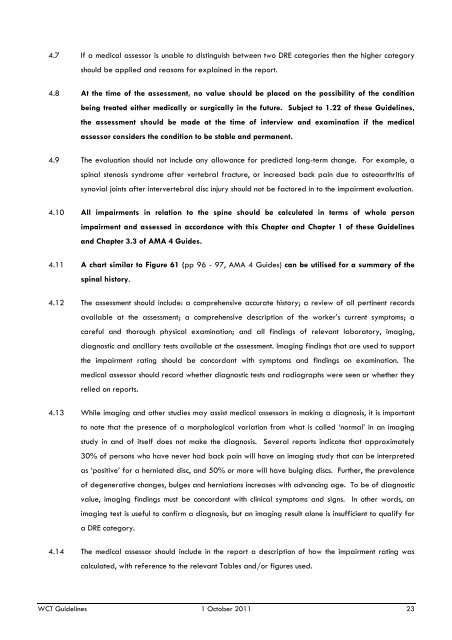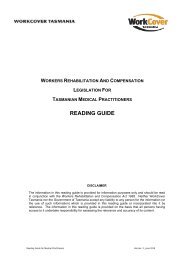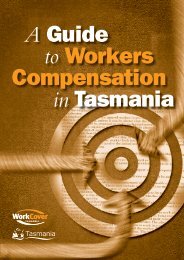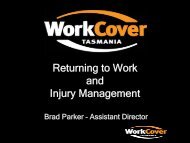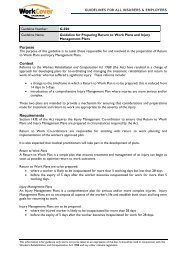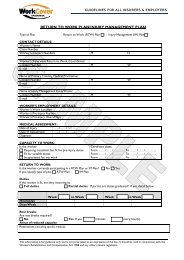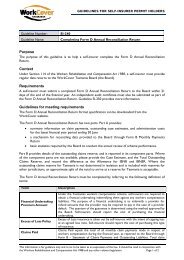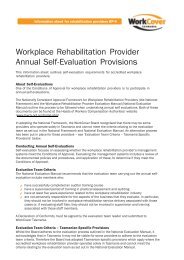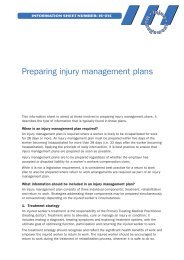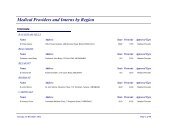Guidelines for the assessment of permanent impairment Version 3
Guidelines for the assessment of permanent impairment Version 3
Guidelines for the assessment of permanent impairment Version 3
You also want an ePaper? Increase the reach of your titles
YUMPU automatically turns print PDFs into web optimized ePapers that Google loves.
4.7 If a medical assessor is unable to distinguish between two DRE categories <strong>the</strong>n <strong>the</strong> higher categoryshould be applied and reasons <strong>for</strong> explained in <strong>the</strong> report.4.8 At <strong>the</strong> time <strong>of</strong> <strong>the</strong> <strong>assessment</strong>, no value should be placed on <strong>the</strong> possibility <strong>of</strong> <strong>the</strong> conditionbeing treated ei<strong>the</strong>r medically or surgically in <strong>the</strong> future. Subject to 1.22 <strong>of</strong> <strong>the</strong>se <strong>Guidelines</strong>,<strong>the</strong> <strong>assessment</strong> should be made at <strong>the</strong> time <strong>of</strong> interview and examination if <strong>the</strong> medicalassessor considers <strong>the</strong> condition to be stable and <strong>permanent</strong>.4.9 The evaluation should not include any allowance <strong>for</strong> predicted long-term change. For example, aspinal stenosis syndrome after vertebral fracture, or increased back pain due to osteoarthritis <strong>of</strong>synovial joints after intervertebral disc injury should not be factored in to <strong>the</strong> <strong>impairment</strong> evaluation.4.10 All <strong>impairment</strong>s in relation to <strong>the</strong> spine should be calculated in terms <strong>of</strong> whole person<strong>impairment</strong> and assessed in accordance with this Chapter and Chapter 1 <strong>of</strong> <strong>the</strong>se <strong>Guidelines</strong>and Chapter 3.3 <strong>of</strong> AMA 4 Guides.4.11 A chart similar to Figure 61 (pp 96 - 97, AMA 4 Guides) can be utilised <strong>for</strong> a summary <strong>of</strong> <strong>the</strong>spinal history.4.12 The <strong>assessment</strong> should include: a comprehensive accurate history; a review <strong>of</strong> all pertinent recordsavailable at <strong>the</strong> <strong>assessment</strong>; a comprehensive description <strong>of</strong> <strong>the</strong> worker’s current symptoms; acareful and thorough physical examination; and all findings <strong>of</strong> relevant laboratory, imaging,diagnostic and ancillary tests available at <strong>the</strong> <strong>assessment</strong>. Imaging findings that are used to support<strong>the</strong> <strong>impairment</strong> rating should be concordant with symptoms and findings on examination. Themedical assessor should record whe<strong>the</strong>r diagnostic tests and radiographs were seen or whe<strong>the</strong>r <strong>the</strong>yrelied on reports.4.13 While imaging and o<strong>the</strong>r studies may assist medical assessors in making a diagnosis, it is importantto note that <strong>the</strong> presence <strong>of</strong> a morphological variation from what is called ‘normal’ in an imagingstudy in and <strong>of</strong> itself does not make <strong>the</strong> diagnosis. Several reports indicate that approximately30% <strong>of</strong> persons who have never had back pain will have an imaging study that can be interpretedas ‘positive’ <strong>for</strong> a herniated disc, and 50% or more will have bulging discs. Fur<strong>the</strong>r, <strong>the</strong> prevalence<strong>of</strong> degenerative changes, bulges and herniations increases with advancing age. To be <strong>of</strong> diagnosticvalue, imaging findings must be concordant with clinical symptoms and signs. In o<strong>the</strong>r words, animaging test is useful to confirm a diagnosis, but an imaging result alone is insufficient to qualify <strong>for</strong>a DRE category.4.14 The medical assessor should include in <strong>the</strong> report a description <strong>of</strong> how <strong>the</strong> <strong>impairment</strong> rating wascalculated, with reference to <strong>the</strong> relevant Tables and/or figures used.WCT <strong>Guidelines</strong> 1 October 2011 23


